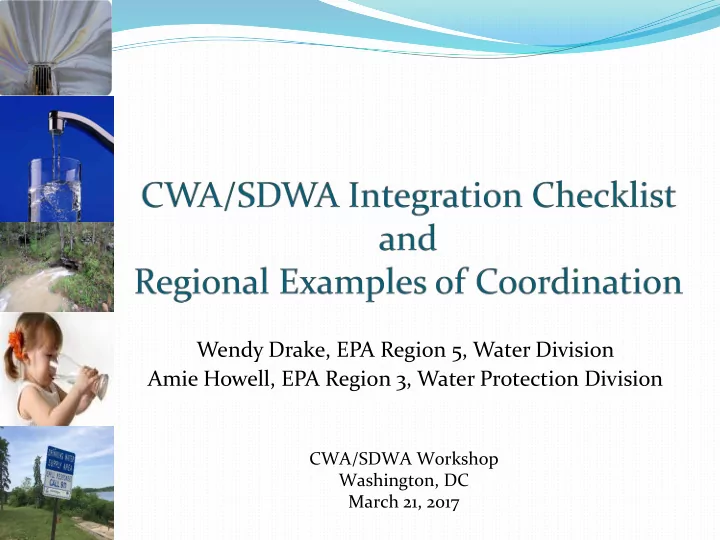

Wendy Drake, EPA Region 5, Water Division Amie Howell, EPA Region 3, Water Protection Division CWA/SDWA Workshop Washington, DC March 21, 2017
Outline Draft CWA/SDWA Integration Checklist Purpose: voluntary, self-assessments at state and EPA regional levels EPA Region 5 Examples of CWA/SDWA activities in Region 5 and next steps EPA Region 3 Region 3 CWA/SDWA integration self-assessment and next steps Examples of CWA/SDWA activities in Region 3
SDWA/CWA Integration Opportunities Holistic, integrated approach to water quality problems—achieve mutual goals Leverage other program resources Broader stakeholder involvement Prevent missed opportunities, solutions that become problems Achieve total watershed goals
DRAFT CWA/SDWA Integration Checklist Region 5 CWA/SDWA integration team created a draft checklist to: Voluntarily self-assess, document, and understand CWA/SDWA integration efforts at the regional and state levels Companion to toolkit Checklist can help identify where to focus collaboration efforts (e.g., developing state-specific CWA/SDWA workshop agendas) 4
DRAFT CWA/SDWA Integration Checklist (cont’d.) Topics include: Water quality standards (WQS) for drinking water use Monitor/assess WQS attainment for drinking water use List impaired waters for drinking water use impairments TMDL development for drinking water use impairments in source waters Integrated watershed planning/implementation Control nonpoint sources Control point sources with permits Enforcement Special initiatives and continuing planning process Source water protection program
DRAFT CWA/SDWA Integration Checklist (cont’d.) Example questions Water quality standards (WQS) for drinking water use Are waterbodies used for drinking water designated as such? Monitor/assess WQS attainment for drinking water use Are parameters and/or indicators being monitored for waterbodies designated for the drinking water use? List impaired waters for drinking water use impairments Is the state listing drinking water use impairments with associated pollutants and causes/sources of impairments? 6
DESCRIPTION/ PROGRAM AND STATE-SPECIFIC QUESTIONS YES NO EXPLANATION: CONTROL NONPOINT SOURCES: The purpose of the questions below are to determine whether SWP is incorporated into the state CWA Section 319 and Clean Water State Revolving Fund (CWSRF) programs, where appropriate. State program contact(s): Please list any names here as appropriate. a. Do the state CWA Section 319 program assessment and management plans mention SWP? Please describe. b. Does the state’s Section 319 grant solicitation process mention SWP? Please describe. c. As the state revises their Section 319 management plans, is the source water protection program routinely providing review and comment on the plan? Please describe. i. Has the state recently updated their plan, and does it include SWP? Please describe. Note: In general, states revise their plans every five years, and each Region 3 state is on a different schedule. Any activity funded by Section 319 funds must be discussed in these plans. d. Is the state drinking water program involved in the review of Section 319 grant applications in SWP areas? Please describe. e. Does the state prioritize funding for controlling nonpoint sources in source waters through the CWSRF program and intended use plan (IUP)? Please describe. f. Do the state’s NPS and SWP programs coordinate with the CWSRF program? Please describe. g. Do any state program-specific (Section 319 or CWSRF) checklists/SOPs/methodologies/etc. exist that incorporate SWP for non-point source control? Please describe. i. If so, have these documents been shared with state SWP programs? Please describe.
Examples of Region 5 CWA/SDWA activities Water Division CWA/SDWA team Self-assessment using the CWA/SDWA integration checklist Joint review of state monitoring strategies, impaired water lists, and state nutrient reduction strategies, etc. Multiple joint CWA/SDWA director meetings Priority: Water quality standards, monitoring, and assessments WI and MN drinking water designated use workshops—replicate in other Region 5 states? 8
WI and MN Workshop Goals Draft an assessment methodology that reasonably and appropriately identifies waters impaired for drinking water use Contain enough detail to be implementable in the next two years Form foundation for future enhancements for future listing cycles
Workshop Conclusions SDWA/CWA integration can be a big topic; narrow focus for workshops Identify clear outcomes Manage size for robust discussions Cover background material and educate in advance (e.g., via webinars) and do homework to hit the ground running
EPA Region 3 CWA/SDWA Integration Self Assessment Presented state Checklist at 2015 Annual EPA/State/Interstate Water Directors Meeting Formed R3 Water Protection Division ad hoc Integration Team and completed Checklist – Spring 2016 Summarized and shared initial results with Integration Team Conducted follow-up meetings with individuals to gather additional information and identify activities to improve coordination – Fall 2016
EPA Region 3 CWA/SDWA Integration Self Assessment – Next Steps Developing list of actions to memorialize commitments between CWA and SDWA programs Identify priority actions to address over the next year, working with state partners
Examples of Region 3 CWA/SDWA Activities Joint CWA/SDWA Water Directors meetings 2016 Algae Summit Delaware Estuary Comprehensive Conservation and Management Plan revision Octoraro Creek Watershed Integrated Performance Team
Examples of Region 3 CWA/SDWA Activities NPDES Permits Downstream notification requirements Reviewing state permit writer tools to verify capability to ensure drinking water protection Leveraging funding and technical assistance West Virginia CWA Section 319 Lower Susquehanna Source Water Protection Partnership CWA Section 106 Eastern Lancaster County SWC Chesapeake Bay CWA Section 117 EPA nutrient reduction technical assistance
Thank you Amie Howell, EPA Region 3, Water Protection Division, Drinking Water Branch 215.814.5722 howell.amie.@epa.gov Wendy Drake, EPA Region 5, Water Division, Ground Water and Drinking Water Branch 312.886.6705 drake.wendy@epa.gov
Recommend
More recommend